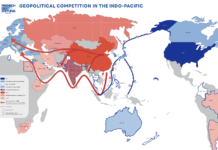Rizwan Zeb
Caesar had his legions, Napoleon had his armies. Words are the new weapons, satellites the new artillery.
Who has not heard of “hybrid war”? Perhaps, someone who has never read a newspaper or watched a news channel. Hybrid warfare is the new buzz word. Apparently, this is a new type of warfare or is it? Before we attempt to define Hybrid warfare, we first need to understand the background of the term.
Russian offensive into Ukraine and Crimea, Hizbullah’s successful campaign against Israeli Defence Force and the rise of non-state actors like Daesh or ISIL have resulted in a view that the world is facing a new form of warfare: hybrid warfare. What is common in all these cases and what combines them that can be used in favor of their argument by the proponents of hybrid warfare? For some, it is a “catch-all for Russian hostility,” for other’s it is the advancement of territorial ambitions using military tactics of an armed non-state actor namely ISIL.
For NATO and EU, hybrid warfare is all about Russia. Currently, NATO is working on strategies that can be utilized to counter the Russian so-called hybrid war capability. At the core of this debate is an older concept popularly known as the concept of Soviet Deep Battle. Another similar manifestation is the Gerasimov Doctrine focusing on multidimensional war. However, there is little evidence to support that Hybrid war is Kremlin’s invention.
Dictionary meaning of Hybrid is “a living thing produced from parents of different breeds and “a machine that contains parts of different machines.” Hybrid warfare implies that it is a war that includes more than one form or mode of war.
Despite its notoriety, one yet has to see a definition of Hybrid warfare that is universally agreed or accepted. At present, a number of definitions are in circulation.
Most popularly used definition is by Frank Hoffman. According to him hybrid warfare is “any adversary that simultaneously and adaptively employs a fused mix of conventional weapons, irregular tactics, terrorism and criminal activities in the battle space to obtain their political objectives.” Glenn defines hybrid war as “when an adversary that simultaneously and adaptively employs some combination of (1) political, military, economic, social, and information means, and (2) conventional, irregular, catastrophic, terrorism, and disruptive/criminal warfare methods. It may include a combination of state and non-state actors.”
According to Frank Hoffman, conventional weapons, unconventional tactics including the use of terror and criminal behavior play a significant role. In such a war, population of a country is the primary target of an enemy’s onslaught be it a physical or psychological attack or a combination of both. The most significant aspect of hybrid war is the effective use of different means and modes of warfare to achieve its objective by the party waging such an attack.
Defense against a hybrid war would be gauged by how successfully an actor has secured its population, infrastructure and economy.
John McCuen argues that hybrid warfare is fought on both physical and conceptual battlegrounds implying that the actual war is the war to influence the hearts and minds of your adversary. All in all, a detailed survey of existing literature on hybrid warfare identifies following attributes of hybrid warfare: superior and effective use of conventional capabilities primarily using unconventional tactics and means focusing on political, economic and social attributes of a country or a society.
In sum, according to the proponents of hybrid war, a hybrid adversary could be a state or a non-state actor or a combination of both, using non-standard methods and ways of war. At the same time, it would be highly flexible. The weapons used in this war are not the battlefield tanks and fighter jets alone. The battlefield for such a war would include TV lounges, sitting and common rooms, population centers in the enemy country and the international community.
Hybrid warfare is in vogue these days and increasingly becoming the part of the military vocabulary the world over. One often hears that this is the age of hybrid warfare and the rules of the game are changing and war is no more a simple and a linear concept. However, the notion of hybrid warfare has its own limitations and flaws. First of all, it is a vague concept and no one is really sure what exactly it means and how it is different from other similar or identical concepts. Concepts such as Mar Kaldor’s ‘new wars’ that points that in post-Cold War era, wars would be fought by both state and non-state actors; US Marine Corp’s concept of 4GW: fourth generation warfare that focuses on the weakening of the state institutions and how non-state actors would use it to their advantages; Chinese Army’s concept of ‘unrestricted warfare’ focusing on adversary’s economic and social interest by waging a media war against it to name just a few such concepts that furnish similar if not overlapping ideas to what is now projected as a hybrid warfare. Military history is rich with such examples where a state used multiple means to hurt its enemy: Iberian leader Virathus expedition against Sertorius in 2nd century BC is among the earliest examples of what is today defined as Hybrid Warfare. Numerous other examples exist in military history such as Rome versus Germania around 9 AD, during the Napoleonic Wars, the American Revolution, Carrera’s resistance against the liberals in Guatemala.
Another important and more recent example of using such a tactic in a war is Salami slicing presented by Thomas Schelling in his magnum opus Arms and Influence. Using this, an actor can achieve its objectives one by one denying the adversary the space to respond massively without being accused of escalation.
To sum up, one can infer that hybrid warfare is still a concept that is evolving and even those who believe that it is a distinct and a newer form of warfare have yet to come up with a clear and universally acceptable definition. Even if it happens, the issue of coming up with a definitive definition would remain. Given that history is replete with numerous examples of such military campaigns that can be defined as clear and precise examples of hybrid wars, terming it as a new idea would be challenging, to say the least.
As for Pakistan, one has come across numerous statements that a hybrid war is currently going on against Pakistan. This line of reasoning argues that Pakistan is under at least eight different types of attacks: economic, foreign involvement in instigating internal unrest in the country, propaganda, adverse diplomatic campaign against Pakistan, cyber-attacks and, terrorism are prime amongst these.
On the face of it, this is an onslaught Pakistan has not faced before and it requires a new and comprehensive strategy to respond. Yet on a close scrutiny one can see that this is not the first time Pakistan is facing such an onslaught. It encountered such attacks when it was considered and projected as an unviable project, when its waters were blocked, when insurgencies were supported and abated by regional countries and especially when it was disintegrated in 1971.
Having said that, one can argue that the magnitude of the onslaught Pakistan is facing at the moment is multifold and ginormous. Pakistan’s armed forces are cognizant of this fact and fully equipped and ready to counter this threat. All wars need national unity and the backing of the whole nation to the defenders of the country. Call this whatever you may but to effectively overcome it, the whole nation needs to unite and support the effort. One country, one nation that is the whole point.
Dr. Rizwan Zeb is chair, Department of Social Sciences, Iqra University, Islamabad.

















